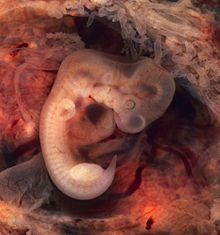Atavism
This article possibly contains original research. (May 2023) |

In
In social sciences, atavism is the tendency of reversion. For example, people in the modern era reverting to the ways of thinking and acting of a former time.
The word atavism is derived from the Latin atavus—a great-great-great-grandfather or, more generally, an ancestor.
Biology
Evolutionarily traits that have disappeared phenotypically do not necessarily disappear from an organism's DNA. The gene sequence often remains, but is inactive. Such an unused gene may remain in the genome for many generations.[4][7] As long as the gene remains intact, a fault in the genetic control suppressing the gene can lead to it being expressed again. Sometimes, the expression of dormant genes can be induced by artificial stimulation.
Atavisms have been observed in humans, such as with infants born with
Other examples of observed atavisms include:
- Hind limbs in
- Extra toes of the modern horse.[3][13][14]
- Reappearance of limbs in limbless vertebrates.[3][6][15]
- Re-evolution of sexuality from parthenogenesis in oribatid mites.[16]
- Teeth in avian dinosaurs (birds).[17]
- Dewclaws in dogs.[3]
- Reappearance of prothoracic wings in insects.[18][19]
- Reappearance of wings on wingless stick insects and leaf insects[20] and earwigs.[3]
- Atavistic muscles in several birds[21][22] and mammals such as the beagle[23] and the jerboa.[21]
- Extra toes in
- Reemergence of sexual reproduction in the Hieracium pilosella and the Crotoniidae family of mites.[25]
- Webbed feet in adult axolotls.[26]
- supernumerary nipples in humans (and other primates).[3]
- Color blindness in humans.[28]
Culture
Atavism is a term in
University of London professor Guy Standing has identified three distinct sub-groups of the precariat, one of which he refers to as "atavists", who long for what they see as a lost past.[30]
Social Darwinism
This section needs additional citations for verification. (May 2023) |
During the interval between the acceptance of
In addition, the concept of atavism as part of an individualistic explanation of the causes of criminal deviance was popularised by the Italian criminologist Cesare Lombroso in the 1870s.[31] He attempted to identify physical characteristics common to criminals and labeled those he found as atavistic, 'throw-back' traits that determined 'primitive' criminal behavior. His statistical evidence and the closely related idea of eugenics have long since been abandoned by the scientific community, but the concept that physical traits may affect the likelihood of criminal or unethical behavior in a person still has some scientific support.[32]
See also
References
- .
- ^ "Multi-cell Organisms". Universe-review.ca. Retrieved 2011-09-29.
- ^ S2CID 29258934
- ^ S2CID 40851098.
- ISBN 978-0-521-73233-8.
- ^ S2CID 27868367
- PMID 14728776.
- ^ "29+ Evidences for Macroevolution: Part 2". Archived from the original on 29 October 2006. Retrieved 2006-11-08.
- ^ "What our tails tell us". Los Angeles Times. 2007-02-15. Archived from the original on 12 March 2009. Retrieved 2009-03-08.
- PMID 21224948.
- ^ "Dino-Chicken Gets One Step Closer". Live Science. 19 May 2015.
- ^ Hiroko Tabuchi (November 5, 2006), Dolphin May Have 'Remains' of Legs, Livescience.com
- PMID 15373256.
- ^ Simpson, G. G. (1951), Horses: The story of the horse family in the modern world and through sixty million years of evolution, Oxford University Press[page needed]
- ^ Raynauad, A. (1977), Somites and early morphogenesis in reptile limbs. In Vertebrate Limb and Somite Morphogenesis, Cambridge University Press, London, pp. 373–386
- PMID 17438282
- PMID 16488870
- PMID 27853616.
- S2CID 25126171.
- S2CID 962571
- ^ JSTOR 1367290
- JSTOR 1366113
- S2CID 33397424
- ^ William E. Castle (1906), The origin of a polydactylous race of guinea-pigs (49 ed.), Carnegie Institution of Washington
- PMID 17438282.
- .
- PMID 6373560
- ISBN 978-0-262-01385-7.
- ^ Joseph Schumpeter (1969). "Imperialism and Capitalism". Imperialism and Social Classes. Cleveland: The World Publishing Company.
- ^ Guy Standing (2016-11-09). "Meet the precariat, the new global class fuelling the rise of populism". World Economic Forum.
- ^ "Lombroso and the pathological perspective can be traced back to the 19th century following a history of demonic and classical perspectives". Criminology.fsu.edu. 2000-11-27. Archived from the original on 2013-09-23. Retrieved 2013-12-04.
- PMID 21733897.
External links
- Bar-Maor, JA; Kesner, KM; Kaftori, JK (November 1980). "Human tails". The Journal of Bone and Joint Surgery. British Volume. 62-B (4): 508–510. PMID 7430236.
- Photograph of an additional (third) hoof of cows
